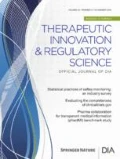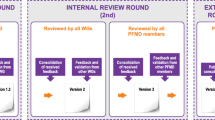Abstract
The value of patient involvement (PI) in medicines research and development (R&D) is increasingly recognized by all health stakeholders. Despite numerous ongoing PI initiatives, PI so far lacks structure and consistency in approach. Limited formal documentation of PI activities further hampers the sharing of experience and learnings, preventing timely and systematic implementation. This article summarizes the outcomes of several multistakeholder discussions during 2013-2016 in a practical roadmap for PI in medicines R&D. The roadmap highlights specific opportunities for PI along the 4 key stages of the medicines R&D life cycle and is illustrated with concrete examples. This roadmap’s aim is to provide a tool to facilitate PI during medicines research and development and is being shared to encourage implementation and further refinement.
Similar content being viewed by others
References
Phillips AG, Hongaard-Andersen P, Moscicki RA, et al. Proceedings of the 2013 CINP summit: innovative partnerships to accelerate CNS drug discovery for improved patient care. Int J Neuropsychopharmacol. 2014;18.
Hoos A, Anderson J, Boutin M, et al. Partnering with patients in the development and lifecycle of medicines—a call for action. Therapeutic Innovation & Regulatory Science. 2015;49:929–939.
Wicks P, Lowe M, Gabriel S, Sikirica S, Sasane R, Arcona S. Increasing patient participation in drug development. Nat Biotechnol. 2015;33:134–135.
Parsons S, Starling B, Mullan-Jensen C, Tham SG, Warner K, Wever K; Needs Assessment Work Package of European Patients’ Academy on Therapeutic Innovation (EUPATI) Project. What the public knows and wants to know about medicines research and development: a survey of the general public in six European countries. BMJ Open. 2015;5:e006420.
Supple D, Roberts A, Hudson V, et al. From tokenism to meaningful engagement: best practices in patient involvement in an EU project. Research Involvement and Engagement 2015:10.1186/s40900-015-0004-9.
PatientPartner Deliverable 2.1. Literature search. http://www.patientpartner-europe.eu/en/resources. Accessed September 13, 2015.
Ioannidis JP, Greenland S, Hlatky MA, et al. Increasing value and reducing waste in research design, conduct, and analysis. Lancet. 2014;383:166–175.
Donovan J, Mills N, Smith M, et al. Quality improvement report: improving design and conduct of randomised trials by embedding them in qualitative research: ProtecT (prostate testing for cancer and treatment) study. Commentary: presenting unbiased information to patients can be difficult. BMJ. 2002;325:766–770.
Mavris M, Le Cam Y. Involvement of patient organisations in research and development of orphan drugs for rare diseases in Europe. Mol Syndromol. 2012;3:237–243.
International Ethical Guidelines for Health-related Research Involving Humans, Fourth Edition. Geneva: Council for International Organizations of Medical Sciences (CIOMS); 2016.
DiMasi JA, Grabowski HG, Hansen RW. Innovation in the pharmaceutical industry: new estimates of R&D costs. Boston: Tufts Center for the Study of Drug Development, November 18, 2014. http://csdd.tufts.edu/news/complete_story/cost_study_press_event_webcast. Accessed September 13, 2015.
Levy M, Rizansky A. Market failure in the pharmaceutical industry and how it can be overcome: the CureShare mechanism. Eur J Health Econ. 2014;15:143–156.
Chalmers I, Glasziou P. Avoidable waste in the production and reporting of research evidence. Lancet. 2009;374:86–89.
Chalmers I, Bracken MB, Djulbegovic B, et al. How to increase value and reduce waste when research priorities are set. Lancet. 2014;383:156–165.
Al-Shahi Salman R, Beller E, Kagan J, et al. Increasing value and reducing waste in biomedical research regulation and management. Lancet. 2014;383:176–185.
Chan AW, Song F, Vickers A, et al. Increasing value and reducing waste: addressing inaccessible research. Lancet. 2014;383:257–266.
Glasziou P, Altman DG, Bossuyt P, et al. Reducing waste from incomplete or unusable reports of biomedical research. Lancet. 2014;383:267–276.
Geissler J, Sharf G, Bombaci F, et al. Factors influencing adherence in CML and ways to improvement: Results of a patient-driven survey of 2546 patients in 79 countries. J Cancer Res Clin Oncol. 2017. doi:10.1007/s00432-017-2372-z.
Brown MT, Bussell JK. Medication adherence: WHO cares? Mayo Clin Proc. 2011;86:304–314.
Haynes RB, McDonald HP, Garg AX. Helping patients follow prescribed treatment: clinical applications. JAMA. 2002;288:2880–2883.
EUPATI 2014. EUPATI literature review. Exploring patients’ and the public’s knowledge, beliefs and understanding of medicines research and development. Evidence summary document. Work Package 3 (available on request from corresponding author).
Menon D, Stafinski T, Dunn A, Wong-Rieger D. Developing a patient-directed policy framework for managing orphan and ultra-orphan drugs throughout their lifecycle. Patient. 2015;8:103–117.
Regulation (EU) No 536/2014 of the European Parliament and of the Council of 16 April 2014 on clinical trials on medicinal products for human use, OJ L 158, 27.5.2014, p. 1–76, Annex I.
European Medicines Agency. The patient’s voice in the evaluation of medicines: how patients can contribute to assessment of benefit and risk. http://www.ema.europa.eu/docs/en_GB/document_library/Report/2013/10/WC500153276.pdf.
EUPATI Guidance Documents for Patient Involvement in Medicines R&D, EUPATI 2016. https://www.eupati.eu/guidance-patient-involvement/.
Mullins CD, Vandigo J, Zheng Z, Wicks P. Patient-centeredness in the design of clinical trials. Value Health. 2014;17:471–475.
Author information
Authors and Affiliations
Corresponding author
Rights and permissions
About this article
Cite this article
Geissler, J., Ryll, B., di Priolo, S.L. et al. Improving Patient Involvement in Medicines Research and Development: A Practical Roadmap. Ther Innov Regul Sci 51, 612–619 (2017). https://doi.org/10.1177/2168479017706405
Received:
Accepted:
Published:
Issue Date:
DOI: https://doi.org/10.1177/2168479017706405



